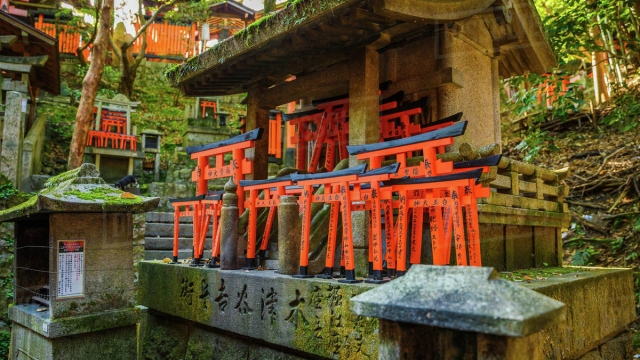
In the heart of Japan, nestled among ancient trees and serene landscapes, lie the enchanting Shinto shrines that embody the spiritual essence of this remarkable culture. Each shrine serves as a gateway to a world of tranquility, where the hustle and bustle of modern life fades away, allowing visitors to connect with nature and the divine. Shinto, the indigenous faith of Japan, celebrates the beauty of the natural world and its myriad of kami, or spirits, believed to inhabit everything from towering mountains to flowing rivers.
As you wander through the tranquil pathways lined with sacred torii gates and lush greenery, you’ll discover that these Shinto shrines are not just places of worship but also havens for reflection and peace. The architectural beauty combined with the simplicity of the surroundings invites a sense of calm, drawing visitors into a meditative state. Whether you are seeking spiritual enlightenment or simply a moment of serenity, the Shinto shrines in Japan promise an unforgettable experience that resonates deeply within the soul.
History of Shinto Shrines
神社
Shinto shrines in Japan have a rich and intricate history that dates back to ancient times. The origins of Shinto can be traced to the indigenous beliefs and practices of the Japanese people, which revolved around the veneration of kami or spirits associated with natural elements and ancestors. Over time, these animistic beliefs coalesced into a more organized religious framework, leading to the establishment of shrines dedicated to various deities, each reflecting the local culture and environment.
The construction of Shinto shrines began to formalize during the Asuka period (around 550 to 710 AD) when rituals and practices started to be codified. This period saw the influence of Buddhism and other continental philosophies, which blended with traditional Shinto beliefs. The architecture of shrines evolved, with distinct styles emerging, such as the shinmei-zukuri and nagare-zukuri, reflecting the artistic and spiritual ideals of the time. These early shrines served not only as places of worship but also as community centers where social and cultural activities flourished.
As Japan moved into the Heian period (794 to 1185 AD), Shinto shrines gained further prominence and recognition. The establishment of the imperial court’s rituals strengthened the connection between the state and Shinto, leading to the integration of shrines into the fabric of Japanese society. This era also witnessed the rise of famous shrines such as Ise Jingu and Fushimi Inari Taisha, which continue to attract pilgrims and tourists today. The historical journey of Shinto shrines is a testament to the enduring nature of Japan’s spiritual heritage and its ability to adapt to the changing cultural landscape.
Architectural Features
Shinto shrines in Japan are renowned for their unique architectural style that reflects the harmony between nature and spirituality. One of the most distinctive elements of shrine design is the use of natural materials, primarily wood, which connects the structures to the surrounding environment. The buildings often feature thatched roofs, which not only enhance their aesthetic appeal but also serve practical purposes, such as insulation and protection from the elements. These roofs, typically raised at the edges, give a sense of lightness and elegance, inviting visitors to experience the beauty of the shrines.
Another significant aspect of shrine architecture is the torii gate, which stands at the entrance and symbolizes the transition from the mundane to the sacred. These gates can vary in size and style, from simple wooden structures to more elaborate stone designs, each representing different periods and regional variations in Shinto architecture. The torii serves as a welcoming threshold, guiding visitors into the tranquil realm of the shrine, where one can reflect and engage with the spiritual world.
The inner sanctum of a shrine, known as the honden, is typically elevated and houses the deity to whom the shrine is dedicated. Access to the honden is restricted, emphasizing its sacred nature. Surrounding this central structure, you will often find other buildings such as the haiden, where worshippers offer prayers and rituals are conducted. The carefully arranged space, adorned with lanterns, sacred trees, and water basins, enhances the overall atmosphere of peace and reverence, making each visit to the shinto shrines in Japan a deeply moving experience.
Cultural Significance
Shinto shrines in Japan serve as vital cultural landmarks that embody the spiritual heritage and traditions of the Japanese people. They are not just places of worship; they are symbols of the connection between the physical and spiritual worlds. Each shrine is dedicated to kami, the spirits that inhabit natural elements, and this deep-rooted belief fosters a profound respect for nature and the environment. The architecture, rituals, and festivals associated with these shrines reflect the values and aesthetics of Japanese culture, making them central to the community’s identity.
Visiting a Shinto shrine is also a way for individuals to engage with their history and ancestry. Many families have their own shrines where they perform ceremonies and rituals to honor their ancestors or seek blessings for significant life events, such as weddings and the birth of a child. The rituals conducted at these sites, often passed down through generations, reinforce familial bonds and a sense of belonging within the community. Moreover, the vibrancy of local festivals held in conjunction with these shrines highlights the role they play in maintaining cultural traditions and practices.
Additionally, the serene and tranquil atmosphere of Shinto shrines attracts not only worshippers but also tourists seeking peace and reflection. The carefully tended gardens, tranquil pathways, and stunning architecture offer a retreat from the hustle and bustle of modern life. As visitors explore these sacred spaces, they are often captivated by the spiritual ambiance that permeates the environment. This interaction further emphasizes the enduring importance of Shinto shrines in Japanese society as places of reverence, reflection, and community gathering, bridging the past and present in a harmonious continuum.
Visiting Famous Shrines
Japan is home to countless Shinto shrines, each steeped in history and cultural significance. Among them, Fushimi Inari Taisha in Kyoto stands out with its iconic thousands of vermilion torii gates that meander through the wooded slopes of Mount Inari. Visitors can embark on a serene hike that takes them through the gates, experiencing the tranquility of the forest and the sacred atmosphere of this revered site. The charm of Fushimi Inari lies not only in its beauty but also in its deep-rooted connection to rice cultivation, as it honors Inari, the deity of agriculture.
Another remarkable shrine is Meiji Jingu, located in the heart of Tokyo. Dedicated to Emperor Meiji and Empress Shoken, this shrine offers a peaceful oasis amidst the urban hustle. The path leading to the shrine is lined with towering trees, creating a calming environment that invites reflection. Every year, millions of visitors come to Meiji Jingu to pray for blessings, witness traditional ceremonies, and enjoy seasonal festivities. The harmonious blend of nature and spirituality makes this shrine a must-visit for those seeking serenity.
In the coastal city of Kamakura, Tsurugaoka Hachimangu shines as a prominent Shinto shrine dedicated to Hachiman, the god of warriors. With its stunning architecture and beautiful gardens, it provides a striking glimpse into Japan’s rich heritage. The approach to the shrine is marked by a large stairway that leads to the primary hall, where visitors can partake in rituals and soak in the atmosphere of historical significance. The shrine is not only a place of worship but also a cultural hub, often hosting events and traditional performances that celebrate the vibrant local community.


